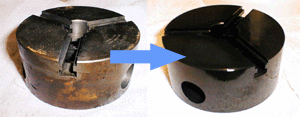|
|
Black oxide coating Last updated: 05 Dec 2016 |

My workshop is located in the garage along with the tumble drier. The moisture from the dryer will frequently attack unprotected steel and iron components. The simple solution is to coat with WD-40 or similar, although this is not always convenient or safe, especially for items used for work holding.
Enter the black oxide starter kit from GLR... This is a four part room temperature chemical kit that works well.
 |
8-Dec-2002: This is the "patient", my three jaw chuck which seems to attract more rust than anything else around. It has been cleaned with Solvol Autosol twice in the last month. As you can see, it's rusty as anything yet again and needs a good cleaning with wire wool and scouring cream. |
 |
Step 1: After a thorough cleaning, it has
been cleaned in hot water and detergent. The tub on the left holds
the hydrochloric acid solution used for degreasing the part.
This bubbles vigorously as it eats all the stuff missed by the wire wool etc. Heating the solution slightly seems to make it a lot more efficient. From this point it is not possible to handle the material by hand as fingerprints will get left on it and wreck the finish. |
 |
Step 2: This is the backplate which has been scrubbed up and through the degreaser already. It's now been treated to the conditioning solution for a few minutes prior to being "blacked". |
 |
Step 3: Into the blacking solution, this has been in there for about a minute. There are a couple of silvery bits on the spindle boss - I'm guessing these are very small pieces of aluminium which have been pressed into the cast iron over the years. |
 |
Another couple of minutes and it's starting to look very black. Time to pull it out and give it a rinse. |
 |
Step 4: Into the sealing solution for 10 minutes. Not sure what this stuff actually is, but it contains white spirit and appears to be a very thin varnish. |
 |
Done. Still coated with some of the sealer, the part is left for 45 mins and then wiped dry. |
 |
Here's the chuck body after coming out of the sealing solution. Very different to the rusty article at the start. |
 |
Here's another one I prepared earlier, the spindle nose for the rotary table. It almost looks professional... |
These pages are maintained by Duncan
Munro. All content on this site is Copyright ©2002-2026 Duncan
Amplification.
Warning: These pages consist of images and descriptions of equipment
which can reach high temperatures creating hazardous and potentially dangerous
situations. These pages should not be taken as a step by step guide on how
to construct any items or carry out any particular procedure, nor should any
references to safety contained herein be taken to guarantee safety in all
situations.